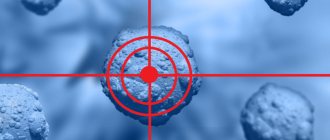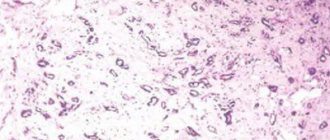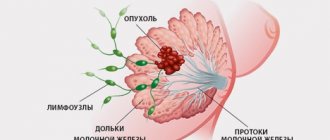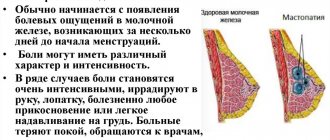Recurrence of breast cancer often develops even after completing a full course of treatment. At the same time, the disease does not always resume its course again a year after complex therapy - sometimes symptoms of relapse of breast cancer can be noticed 10-20 years after treatment. In this condition, the tumor can appear again in the same place, or form in another breast.
What to do if the disease reoccurs? In this case, it is necessary to immediately begin treatment for cancer in order to stop the growth of the malignant neoplasm and maintain the health of the mammary glands.
What is breast cancer recurrence?
Recurrence of cancer after a mastectomy, medication, radiation or other type of therapy is a malignant tumor. Recurrence and metastases of breast cancer can affect the same mammary gland, nearby lymph nodes, or distant tissues of the gland.
If the cancer has recurred in the other breast, the oncologist treats the disease as a separate tumor and creates a new treatment plan. However, its metastasis to bone tissue is also considered as breast cancer and is not a separate pathology.
Thus, there are 3 options for the development of cancer:
- Local - an increase in the number of malignant cells was again recorded in the previously treated breast (in the original location) or on the postoperative scar. It often occurs without obvious symptoms and is regarded as a failure of the treatment therapy.
- Regional – the number of cancer cells increases, affecting the gland tissue and lymph nodes located in the armpits, neck and décolleté (observed in 40% of cases). The pathology takes on a more aggressive form.
- Metastatic (distant) – cancer cells spread through the circulatory and lymphatic systems, infecting distant parts of the body, for example, the liver, brain, lungs. Also, the focus of breast cancer can originate in the opposite breast.
If the tumor manages to recur, it will develop more quickly and aggressively, which, of course, will negatively affect the woman’s health.
When does a tumor manage to recur?
| Risk of relapse | Factors |
| Short | Breast cancer has not affected nearby lymph nodes and vessels, and the size of the tumor is relatively small - up to 2 cm. The patient's age is up to 35 years. Several therapeutic options have been attempted. |
| Moderate | The affected area exceeds 2 cm, and the pathology spreads to nearby blood vessels. The Her2/neu gene was detected or 1-3 lymph nodes were affected. |
| High | Breast cancer was discovered in the last stages. 1-4 or more lymph nodes and the vascular network near the tumor are affected, the Her2/neu gene was detected, the patient’s age is over 35-40 years. The disease is aggressive and has metastasized; the rate of division of malignant cells is increased. One treatment option was undertaken. |
If the patient consults a doctor in a timely manner, which will allow timely initiation of complex therapy for the disease, the survival rate in this case is 60%.
In what cases does oncology develop again?
When a tumor in the chest develops again, it frightens the patient even more than the previous disease. The woman begins to think that the disease cannot be cured completely, and, despite the measures taken, it will continue to occur.
Basically, the manifestation of a neoplasm occurs when, during treatment of breast cancer, doctors fail to completely destroy cancer cells, especially if they have managed to penetrate healthy breast tissue or spread along with the blood to another organ. During surgery, it is difficult to assess the extent of spread of malignant cells, since without their active growth it is impossible to identify a new location of the tumor.
According to oncologists, if more than 6 months have passed after the main therapy, and no metastases were detected during testing, then a repeated exacerbation of the disease is considered a relapse. If, in the postoperative period, new tumor cells were identified, it means that the pathology was not completely cured.
The appearance of a malignant neoplasm in another organ can also be called a relapse. In this case, the tumor cells were transported throughout the body along with the bloodstream, which caused a new focus of infection. Doctors call this phenomenon metastasis of the primary tumor.
The appearance of metastases in a woman’s body suggests that some malignant cells were insensitive to it during therapy. This indicator requires urgent re-operation or conservative therapy, which will preserve the health of the affected organ.
Factors in the development of pathology
Recurrence of breast cancer in women often occurs as a result of specific circumstances. Today, oncologists know a number of factors that serve as the beginning of the recurrence of the disease:
- Form of cancer - if the pathology occurs in an aggressive form, the risk of tumor recurrence increases several times.
- The stage during which doctors were able to identify the disease - if it was discovered late, the percentage of relapse is high.
- A large number of cancer cells in the female body.
- Damage to lymph nodes and blood vessels located near the mammary glands.
- Tumor growth rate and size.
- The birth of the first child after 30-35 years.
- Early menstruation and late menopause.
- A certain type of oncogene found in cancer cells that also often causes the disease to develop.
After completion of treatment, the doctor will assess the risk of recurrence of the cancer process, and will also inform the woman about the need for an annual breast examination.
As a rule, symptoms of relapse of the disease can be noticed at any time after therapy, but often the disease begins to develop again 3-5 years after the end of the treatment course.
Who is at risk
To avoid breast cancer, you need to know which groups of women are most susceptible to developing the pathology.
Statistics show that most often the disease is diagnosed in women 35-45 years old, but sometimes the disease occurs in younger representatives of the fair sex who have reached the age of 25.
To begin with, the risk group includes those women who have a hereditary predisposition to the disease. If breast cancer has been observed in the female line, the disease develops in 50% of cases.
This usually depends on the type of previous therapy (meaning that only one treatment option was attempted, and not a combination of them):
| Type of treatment | Risk of breast cancer recurrence |
| After radiation therapy | Cancer develops in 5-10% of cases |
| After radiotherapy | The risk of re-observing the disease is present in 20-40% of patients |
| After mastectomy | Recurrence of a malignant tumor occurs in 60% of cases |
Thanks to scientific research, it was found that women who have cancer genes in their blood should also be included in the risk group. These genes look like this: BRCA-II on chromosome 13 and BRCA-I on chromosome 17. In this case, metastasis can increase the risk of developing the disease by another 10%.
Relapse rate
If no additional therapeutic measures were taken after the mastectomy operation, then the relapse rate within 5 years reaches 40%. The likelihood of recurrent breast cancer is greatest in the first 2 years, if neither chemotherapy nor radiation exposure was performed.
In this regard, the statistics of those patients in whom the operation was performed at the first stage of the disease are interesting. The study was based on gentle operations - preserving the mammary gland itself and removing only the tumor itself and surrounding tissue. And then they compared the further development of events in the case of complex chemotherapy and radiation exposure to the postoperative field and without them.
It turned out that although there was no damage to the axillary lymph nodes characteristic of stage 1, the relapse rate in the first 5 years without additional treatment reached 32%! At the second stage, recurrence increased to 50%. If, in addition to radical surgery, other therapeutic measures were carried out, recurrent cancer significantly lost its position.
A malignant process in the mammary gland can be considered eliminated only if there is no relapse within the next 5 years after surgery. Interestingly, the likelihood of its occurrence decreases the further the primary operation goes into the past.
What are the dangers of repeated breast cancer?
If breast tumors are not cured in time, the disease will progress rapidly. In 10% of patients who consult a doctor, the disease is already accompanied by metastases. The difficulty of treatment lies in the fact that such patients cannot be subjected to surgery, since they have active growth of metastases or general exhaustion of the body has been identified.
The main danger of the disease is the high mortality rate of women for whom treatment did not help or doctors did not have time to perform the operation. The probability of a complete cure of the disease is only 30%, while in other cases a relapse of the disease is possible.
How does the spread of cells that are not destroyed during treatment? Together with lymphatic fluid or blood flow, malignant cells can penetrate many organs. These include:
- Lungs.
- Peritoneum.
- Brain.
- Skeleton.
- Liver.
- Rib cage.
- Healthy breast tissue, etc.
In this case, the therapy is carried out more comprehensively, which will completely destroy the cancer cells.
Cancer is a dangerous pathology that quickly develops in the body, so early detection of symptoms will help prevent the development of a large tumor that can lead to death in the patient.
Follow-up after breast cancer treatment
In the first 5 years after primary cancer treatment, the risk of relapse is greatest. Therefore, during this period it is necessary to visit the oncologist 1 to 4 times a year (depending on the specific clinical situation). During the appointment, the doctor examines the patient and identifies possible complaints. After 5 years, it is advised to contact a specialist once a year, unless, of course, there are any complaints about the condition.
During the appointment, in addition to the examination, the oncologist will prescribe instrumental research methods that will allow timely detection of breast cancer recurrence or progression of the disease:
- bilateral (in the case of organ-preserving surgery) or contralateral mammography in combination with ultrasound of regional zones and the area of the postoperative scar - once a year;
- scintigraphy of skeletal bones, ultrasound of the abdominal and pelvic organs, radiography of the chest organs - as prescribed by the oncologist.
In addition, women taking adjuvant tamoxifen in the presence of a intact uterus should undergo a routine examination by a gynecologist annually. The fact is that the drug can cause the development of endometrial hyperplasia, and a specialist will notice this in time.
Women taking aromatase inhibitors for a long time are recommended to undergo annual densitometry. This diagnostic method helps assess bone density and the risk of developing osteoporosis.
The first symptoms of the return of the disease
A recurrence of a cancerous tumor can be detected independently - to do this, it is enough to carefully palpate the breast and visit a doctor annually. If the disease is completely cured, the mammary gland will be soft and without hard tubercles or lumps.
The following signs usually indicate the development of a relapse:
- Change in color and appearance of nipples.
- Pathological discharge from the nipple.
- Burning in the chest.
- Itching on the skin of the mammary gland, the presence of ulcers, cracks.
- A separate inflamed area of the chest became marble-like in color.
- Body temperature became higher.
- The appearance of a red spot on the affected area of the chest.
- Changes in the size and contour of the affected gland.
- General exhaustion of the body.
- Decreased appetite.
- Weight loss.
- Anemia and hyperthermia.
- Fatigue, lethargy, loss of strength.
As a rule, these are the symptoms that indicate repeated metastasis, the treatment of which must be carried out in a short time. To avoid relapse after tumor therapy, you should visit your doctor regularly (especially the first couple of years) so that the disease can be detected in time.
Clinical signs
Any patient who has undergone surgery for a malignant breast tumor should know how a relapse manifests itself and contact an oncologist in a timely manner. It must be remembered that its symptoms can occur many years later, when the woman has already been removed from the dispensary register.
Signs of recurrence depend on the type of breast cancer.
Local relapse
The tumor appears in the same area as originally. If a lumpectomy was performed, cancer cells may spread to the remaining gland tissue. After a mastectomy, a tumor may appear in the scar area.
Symptoms:
- uneven density of the gland or the formation of “bumps” in it;
- changes in the skin on the chest, inflammation, redness;
- nipple discharge;
- the appearance of one or more painless nodules under the skin in the scar area;
- the appearance of an area of thickened skin next to the scar after a mastectomy.
Regional relapse
In this case, cancer cells multiply in nearby lymph nodes. This manifests itself as the formation of a lump (“bump”) or swelling in the area under the armpit, above the collarbone or on the neck.
Distant metastases
Cancer cells develop in other organs - bones, lungs, liver, brain. The most common symptoms:
- persistent constant pain in the bones and back that cannot be treated;
- persistent cough;
- shortness of breath, difficulty breathing;
- loss of appetite, weight loss;
- Strong headache;
- convulsive seizures and others.
Necessary diagnostic measures
To determine the prognosis of the disease, a woman should undergo all diagnostic measures that will make it possible to make an accurate diagnosis, as well as identify the structure and degree of the malignant neoplasm.
A doctor will be able to identify breast cancer by examining the patient and listening to the symptoms that worry her. You will also need to undergo a mammogram to confirm the diagnosis.
If using such diagnostic methods it is not possible to confirm the disease, the patient will need to undergo the following research methods:
- Radiography.
- CT scan.
- Radioisotope scanning.
- Blood tests (general and tumor markers).
- Ultrasound.
- MRI.
- PAT.
If a woman has previously undergone surgical treatment, she will need to examine the scars, since it is in them that a recurrent tumor most often develops.
A biopsy is necessary to distinguish between the formation of a new isolated tumor or the recurrence of an old one. When analyzing a biopsy, it will be possible to identify the sensitivity of cancer cells to targeted and hormonal treatment.
Which doctor should I contact?
In the postoperative period and as a preventive measure for breast cancer, it is necessary to visit a mammologist. If he detects oncology in a woman, the doctor will refer the patient directly to an oncologist, since only a specialist will help carry out complex treatment.
If the disease has metastasized to other organs, for example, to the uterus and ovaries, then the woman will also be observed by a specialist in the relevant field - a gynecologist.
Risk categories
In the treatment of breast cancer, it is not officially customary to distinguish risk categories, as in the case of prostate cancer, since the latter does not have such extensive morphological typing. Breast cancer is represented by a huge variety of cell types, it is impossible to take them all into account, and the list of criteria is regularly reviewed and supplemented. However, some clinics use “risk categories” to explain long-term prospects to patients.
In the specialized literature and clinical practice, criteria for unfavorable prognosis are identified that promise a high probability of return of the disease in any form - metastasis or recurrence.
No patterns in the combination and number of unfavorable signs have been identified; it is believed that the more criteria found during microscopy and specific analyses, the worse the prognosis:
- the size of the primary cancer in the gland is more than 5 centimeters,
- tumor lesion of more than four lymph nodes in the armpit,
- low differentiated structure,
- cell possession of the HER2 gene,
- high cancer cell division potential, referred to as Ki67,
- spread of cells beyond the boundaries of the nodular formation, which is indicated in histology as perineural and lymphovascular invasion.
Intraductal breast cancer or DCIS, determined only by microscopy and often of the same volume, does not fit into the prognostic program, always classified as in situ or stage 0 cancer for any node size. Malignant cells in DCIS do not break through the basement membrane of the epithelium, that is, there is no invasion, but cancer complexes are able to survive at a considerable distance from the maternal node, which results in a high frequency of local relapses and therefore requires extensive surgical intervention.
Methods of therapeutic therapy after recurrence of breast cancer
https://youtu.be/YIOHBQfr7Uw
Radical treatment of the disease is carried out using several methods. These include:
- Local treatment of the disease, involving surgery, brachytherapy or radiation therapy.
- Systemic treatment, in which the patient is prescribed targeted or hormonal drugs, as well as chemotherapy.
As a rule, the patient is more often prescribed local treatment in severe cases of the disease. If cancer develops at an early stage, systemic therapy will be required. Also, the type of treatment depends on the frequency of relapses, because sometimes they can occur frequently - this depends on the incomplete destruction of cancer cells, which over time form a new tumor.
If the disease is detected in a woman for the first time, medications can help overcome it. However, the benefit of such therapy will only be if the patient strictly follows the instructions for use of the drugs, does not violate the dosage, and also follows the doctor’s advice.
Often, the reappearance of the disease indicates the aggressiveness of cancer cells, which are not so easy to destroy. In this case, the patient is prescribed complex therapy (both local and systemic), which will completely overcome all pathological cells that could have entered the patient’s organs, tissues or lymph nodes during the first treatment.
Repeated therapy carries a greater chance of full recovery, because the doctor conducts a thorough examination to understand exactly where the cancer cells have spread in the female body. But if the patient does not visit the doctor in a timely manner, breast cancer can affect a large part of the breast - as a result, its removal (partial, complete, with excision of part of the lymph nodes) is required.
Prevention of recurrence of the disease
After a long and difficult treatment, all patients are interested in the question “how to avoid recurrence of breast cancer.” The following methods help prevent recurrence after breast cancer or reduce its risks:
- comprehensive treatment in accordance with international standards;
- for hormone-positive cancer, long-term use of tamoxifen/aromatase inhibitors;
- dynamic observation after completion of the main stage of treatment;
- prevention with agents based on indole-3-carbinol and epigallocatechin-3-galate (Promisan) to restore the activity of tumor-suppressing genes (the gene whose product ensures the prevention of tumor transformation of cells) and BRCA proteins.
similar on topic
Promisan is a unique non-hormonal drug for cancer prevention
READ MORE
In addition to regular monitoring by specialists and systemic therapy, a healthy lifestyle will help prevent breast cancer recurrence. Walking in the fresh air, physical activity, and proper nutrition are the basis of any person’s health. But this is especially important for those who have suffered a serious illness.
You also need to maintain your weight at an optimal level. The fact is that excess adipose tissue is a source of estrogen production. It has been proven that excessive estrogen stimulation negatively affects breast tissue, stimulating the development of proliferative processes. Thus, reducing excess estrogen stimulation also leads to a reduction in the risk of relapse, especially for hormone-dependent types of breast cancer.
How to protect yourself from relapses and metastases?
What can be done to avoid recurrence of the disease? To prevent a relapse, it is necessary to carry out prophylaxis that will avoid the recurrence of the pathology.
As a rule, preventive measures need to be carried out immediately after therapy, since cancer cells can enter the bloodstream, thereby causing recurrent disease.
Preventive measures include:
- Taking special medications that reduce the production of estrogen (a hormone) prevents cancer cells from growing to form a new cancerous tumor in the breast or other organ.
- Weight control – you can’t suddenly lose weight or gain weight. The weight indicator should correspond to your height and age.
- Quitting alcohol and smoking, switching to a balanced diet.
- Observation by a mammologist every 6 months.
- Carrying out therapeutic exercises and massage, especially after surgery.
- Regular breast self-examination.
- Avoid exacerbation of chronic pathologies.
- Taking any hormonal drugs, including contraceptives, must be agreed with your doctor.
- Young women can plan pregnancy with subsequent breastfeeding.
- Taking vitamin complexes and medications that stimulate the immune system.
How much medication do you usually need to take? To avoid re-infection, you should take the drugs for six months.
How to avoid?
Modern research by doctors helps to identify factors in the life of patients that reduce the risk and have a positive effect on preventing the development of the disease. According to professor of medicine Helen Warnen at the University of Toronto, changes in lifestyle can protect against relapse of a dangerous pathology. To reduce the risk of relapse, you need to follow these recommendations:
- Exercise stress. Regular fitness classes help avoid recurrence of the disease and restore health.
- Fight excess weight. Overweight women are much more likely to have the condition return.
- Alcohol. Drinking alcoholic beverages is dangerous. The results of the study were published in the international journal On Cancer in 2020. They said that the disease returned 28% more often in those women who did not get rid of the bad habit.
- Medications. It is important to adhere to medication prescribed by your doctor. They reduce the likelihood of recurrence of the malignant process.
It is important to understand that any recommendations from doctors are not a panacea for the disease. There are types of oncology that are characterized by highly aggressive cancer cells. Therefore, all advice should not replace basic treatment, and regular examination remains the main preventive method.
Disease prediction
With a local relapse after mastectomy, during which the lymph nodes were not affected, patient survival is 75%. In this case, cured patients will be able to live more than 5 years. If metastases are found in the breast, the life expectancy of women is 3 years. Detection of the disease at an early stage allows the disease to be completely cured.
After therapeutic treatment, the patient needs to carry out prevention, as well as monitor the condition of the breast - if growths, burning, thickening, peeling appear on it, it is necessary to visit a doctor, since such signs indicate the development of a malignant tumor. In this case, only a doctor can give a correct assessment of this condition. He will also examine the scar to understand what kind of disease the patient is developing and will give directions for tests.
Timely detection of the disease will help to completely cure it, which will save the patient’s life and will not make it difficult.
Symptoms of relapse
To detect recurrence of breast cancer in a timely manner, it is necessary to regularly visit an oncologist and undergo examinations. However, it is equally important to independently monitor the condition of the chest and mammary glands.
Symptoms of cancer returning may not be obvious. Regular breast examination and understanding of its normal condition will help to identify unwanted changes as early as possible and begin treatment.
Among the most common symptoms of breast cancer recurrence are:
- the appearance of a lump under the skin of the mammary gland (during organ-preserving surgery) or in the area of a postoperative scar;
- change in the structure of breast tissue (during organ-preserving surgery);
- recurrence of breast cancer in a postoperative scar can cause a change in skin color in the scar area (redness).
If you notice signs of breast cancer recurrence, you should immediately contact an oncologist.
Forecasting
Prognosis after recurrence of breast cancer and its treatment is made based on the Nottingham Prognostic Index, computer program scores and the Oncotype DX test.
The Nottingham Prognostic Index is a scale used after surgery to predict the future development of cancer. Three indicators are used in forecasting:
- size of cancer formation;
- number of pathological lymph nodes;
- degree of oncology.
In some cases, specialists use special computer programs online for forecasting. The outcome value is expressed as the percentage of survival after diagnosis. Programs are able to evaluate the benefits of therapy and surgery.
Oncotype DX analyzes a sample of breast cancer tissue to determine its genetic makeup. The test determines the likelihood of relapse and its signs. The program determines the appropriate treatment method for each individual case.
Recurrence of breast cancer is prevented with the help of a comprehensive therapeutic effect on the primary formation. For early detection of secondary pathology, preventive examinations are carried out quarterly for 2 years, and then less frequently.
It is difficult to say how long a person can live after a recurrence of breast cancer. No analysis or test can give an accurate prognosis. When individual metastases are detected, the prognosis worsens significantly.
Resumption of the disease is called 6 months or more after therapy (surgery) if it was not detected during this time.
Recurrence of breast cancer can occur at any time, but most often relapses are recorded 3-5 years after treatment.
A tumor focus during relapse can develop both at the site of the primary tumor (local relapse) and in any other area outside the mammary gland (distant). When a distant location is detected, they speak of metastases from the primary site and relapse of the underlying disease.
Diagnosis of relapse and treatment methods
Timely mammography and self-examination help to diagnose the development of relapse at an early stage. When the first signs appear, you should immediately consult your doctor.
If recurrent breast cancer is suspected, the following is carried out:
- repeat mammography;
- biopsy;
- study to identify cancer markers.
After these tests, studies are carried out to detect cancer and the development of metastases. If required, magnetic resonance imaging and computed tomography are performed. When recurrent breast cancer is detected, a chest x-ray, mammography of the adjacent breast, and densitometry are prescribed. Only after a final diagnosis does the doctor begin treatment.
Before treating a recurrent lesion, the oncologist considers certain factors:
- localization of metastases and their spread;
- characteristics of relapse;
- the duration of the interval between the end of treatment of the primary oncological lesion and the detection of a recurring tumor;
- methods used to combat the primary tumor;
- the effectiveness of hormonal therapy and chemotherapy for primary cancer;
- age and general health of the patient.
Recurrent breast cancer responds well to treatment, but complete cure is difficult to achieve. With the local development of a recurrent formation, correct treatment measures will prolong the patient’s life. Hormone therapy and chemotherapy are usually used. The drug used and the treatment regimen depend on the stage of development of the disease.
Also, the method of treating a recurring tumor depends on the method of treating the original cancer. If lumpectomy was used, then mastectomy is used to combat relapse. During the initial use of mastectomy, radiation is used to treat recurrent disease. Hormone therapy and chemotherapy are used after radiation or surgery.
For recurrent oncology in organs not related to the mammary gland (bones, lungs and brain), systemic therapy is used. To reduce some symptoms, radiation exposure and surgery are used.
In the final stages of recurrent cancer, systemic therapy makes it possible to improve the quality of life, and the patient can live 1-2 years.
Immunotherapy may be prescribed together with chemotherapy or separately. It is used in the treatment of patients whose cancer cells contain a high content of the HER2/neu protein. Immunotherapy is also prescribed when hormonal treatment and chemotherapy are ineffective. After surgical treatment or radiation therapy, the oncologist determines the risk of further manifestations of cancer. In some cases, the use of Tamoxifen or chemotherapy is recommended.










